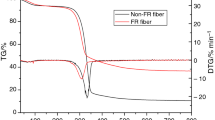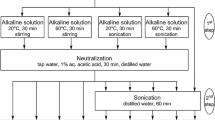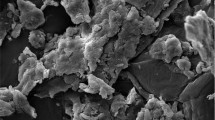Abstract
It is shown that alkaline delignification of flax fibre is polychronic and is characterized by an uneven increase in the maximum effective rate constant when the temperature is increased from 328 to 358 K. It is hypothesized that the jump in kmax is due to a sharp increase in the number of fibre microvolumes accessible to the reagent while their distribution with respect to the kinetic nonequivalence parameter remains unchanged. The reaction of hydrolysis of cellulose with formation of soluble oligosaccharides accompanying alkaline delignification of flax makes it inexpedient to totally remove the lignin by significantly increasing the treatment temperature.
Similar content being viewed by others
REFERENCES
V. Zhivetin, O. Ol’shanskaya, and A. Artemov, Direktor, No. 7, 3–7 (2002).
A. V. Obolenskaya, Laboratory Manual for Wood and Cellulose Chemistry [in Russian], Ekologiya, Moscow (1991).
R. Z. Pen, I. L. Shapiro, and V. R. Pen, Khim. Drevesiny, No. 5, 58–63 (1989).
S. I. Kuzina and A. I. Mikhailov, Dokl. Akad. Nauk SSSR, 231, No.6, 1395–1398 (1976).
O. N. Karpukhin, Usp. Khim., 6, 1119–1143 (1978).
Author information
Authors and Affiliations
Additional information
Translated from Khimicheskie Volokna, No. 6, pp. 5–7, November–December, 2004.
Rights and permissions
About this article
Cite this article
Petrova, S.N., Volkova, I.Y. & Zakharov, A.G. Kinetics of alkaline delignification of flax fibre. Fibre Chem 36, 393–395 (2004). https://doi.org/10.1007/s10692-005-0024-6
Issue Date:
DOI: https://doi.org/10.1007/s10692-005-0024-6




